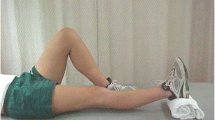Abstract
Treatment once extension contracture of the knee has completed is difficult and costly. The most effective treatment might be the prevention of contracture, especially after joint injury. In order to establish an effective method for contracture prevention we first made an extension contracture in rabbit knees, then studied the effect of a sheet made from hyaluronic acid and carboxymethyl cellulose (HA/CMC) for the prevention of knee contracture. One hundred and twenty two mature male Japanese white rabbits were divided into three groups: (1) group B (n=42), where bony holes were made at the medial and lateral epicondyles, (2) group H (n=40), where HA/CMC sheets were placed on the bony holes, and (3) group S (n=40),where only arthrotomy was performed. All surgical procedures were performed on the right knees. All right knees were fixed at 45° using external fixators; this is the maximum extension angle the rabbit is able to tolerate and still walk. At 1, 3, and 6 weeks after surgery, we measured the moment necessary to flex the knee using a special device. We defined the moment as flexion moment (FM). Forty four left knees were also tested as group N, not operated on and serving as the healthy side. In all groups, FM was increased parallel to the increment of flexion angle from 45° to 115°. At many flexion angles, the FM in group B was higher than those of group S at 3 and 6 weeks. The FM in group H was significantly lower than those of group B at 85° and 95° of flexion at 6 weeks after the operation. By macroscopic observation, the area and degree of adhesion were greater in group B than those of group S. In group H, adhesions around the bony hole were less evident than in group B at 6 weeks after the operation. By histological examination, dense granulation tissue was found adjacent to the bony hole in group B at 3 and 6 weeks after the operation. In contrast, in group H the amount of granulation tissue was smaller at 3 and 6 weeks after the operation than those of group B. The usage of HA/CMC sheet should be effective for prevention of contracture occurring after trauma such as treatment for intra-articular fracture.






Similar content being viewed by others
References
Akeson WH (1961) An experimental study of joint stiffness. J Bone Joint Surg Am 43:1022–1034
Akeson WH, Woo SL, Amiel D, Doty DH (1977) Rapid recovery from contracture in rabbit hindlimb. Clin Orthop 122:359–365
Amiel D, Frey C, Woo SL-Y, Harwood F, Akeson W (1985) Value of hyaluronic acid in the prevention of contracture formation. Clin Orthop 196:306–311
Becker JM, Dayton MT, Fazio VW, Beck DE, Stryker SJ, Wexner SD, Wolff BG, Roberts PL, Smith LE, Sweeney SA, Moore M (1996) Prevention of postoperative abdominal adhesions by a sodium hyaluronate-based bioresorvable membrane:a prospective, rondomized, double-blind multicenter study. J Am Coll Surg 183:297–306
Bothner H, Wik O (1987) Rheology of hyaluronate. Acta Otolaryngol Suppl 442:25–30
Burns JW, Colt MJ, Burgess LS, Skinner KC (1997) Preclinical evaluation of Seprafilm bioresorvable membrane. Eur J Surg Suppl 577:40–48
Diamond MP (1996) Reduction of adhesions after uterine myomectomy by Seprafilm membrane(HAL-F): a blinded, prospective, randomized, multicenter clinical study. Fertil Steril 66:904–910
Evans EV (1960) Experimental immobilization and remobilization of rat knee joints. J Bone Joint Surg Am 42:737–758
Fukui N, Fukuda A, Kojima K, Nakajima K, Oda H, Nakamura K (2001) Suppression of fibrous adhesion by proteoglycan decorin. J Orthop Res 19:456–462
Fukui N, Tashiro T, Hiraoka H, Oda H, Nakamura K (2000) Adhesion formation can be reduced by the suppression of transforming growth factor β-1 activity. J Orthop Res 18:212–219
Fukui N, Nakajima K, Tashiro T, Oda H, Nakamura K (2001) Neutralization of fibroblast growth factor-2 reduces intraarticular adhesions. Clin Orthop 383:250–258
Kuroki K, Cook JL, Kreeger JM (2002) Mechanisms of action and potential uses of hyaluronan in dogs with osteoarthritis. J Am Vet Med Assoc 221:944–950
Olutoye OO, Barone EJ, Yager DR, Uchida T, Cohen IK, Diegelmann RF (1997) R Hyaluronic acid inhibits fetal platelet function: implications in scarless healing. J Pediatr Surg 32:1037–1040
Parisien JS (1988) The role of arthroscopy in the treatment of postoperative fibroarthrosis of the knee joint. Clin Orthop 229:185–192
Rothkopf DM, Webb S, Szabo RM, Gelberman RH, May JW Jr (1991) An experimental model for the study of canine flexor tendon adhesions. J Hand Surg 16:694–700
Woo SL, Matthews JV, Akeson WH, Amiel D, Convery FR (1975) Connective tissue response to immobility. Arthritis Rheum 18:257–264
Acknowledgement
The present study was conducted in accordance with the criteria established by the Institutional Animal Care and Use Committee (IACUC).
Author information
Authors and Affiliations
Corresponding author
Rights and permissions
About this article
Cite this article
Hayashi, M., Sekiya, H., Takatoku, K. et al. Experimental model of knee contracture in extension: its prevention using a sheet made from hyaluronic acid and carboxymethylcellulose. Knee Surg Sports Traumatol Arthrosc 12, 545–551 (2004). https://doi.org/10.1007/s00167-004-0512-x
Received:
Accepted:
Published:
Issue Date:
DOI: https://doi.org/10.1007/s00167-004-0512-x




